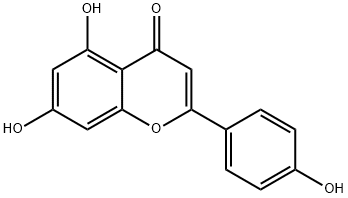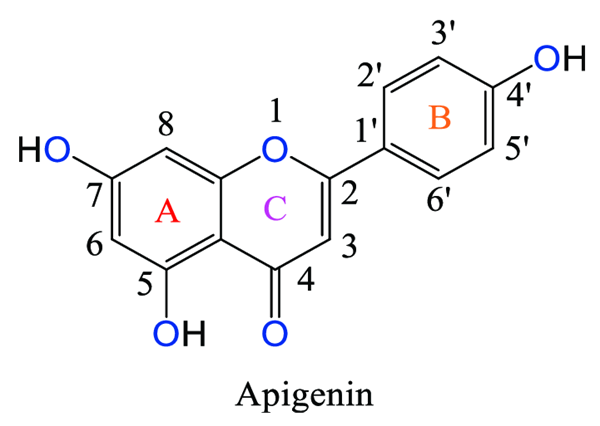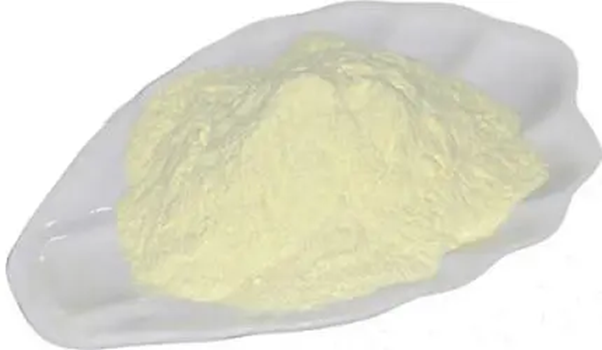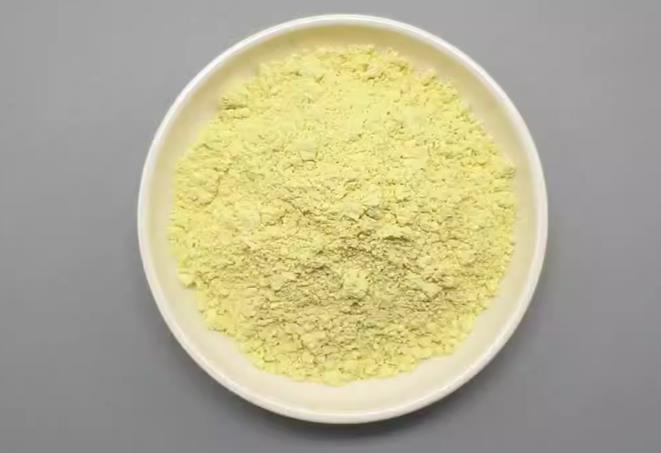What is apigenin?
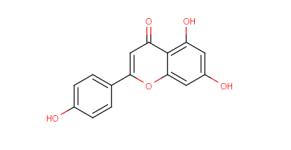
Fig 1. Chemical structure formula of apigenin
Apigenin (C15H10O5, CAS registry No. 520-36-5) is also called 4’,5,7-trihydroxyflavone, which is a pale yellow crystalline solid. Its melting point is 345-350 oC, and flash point is 217 oC. The solubility of apigenin is 27 g/L in DMSO. Apigenin has a very low solubility in water (1.35 μg/mL) and high permeability. Taking into consideration its high permeability, apigenin is categorized as a Class II drug according to Biopharmaceutics Classification System (BCS), whose characteristics are low solubility and high permeability. Pure apigenin is generally regarded as unstable for long term storage at room temperature, and thus it requires storage at -20 oC.
Apigenin is one of the most widespread flavonoids in plants and formally belongs to the flavone sub-class. Of all the flavonoids, apigenin is one of the most widely distributed in the plant kingdom, and one of the most studied phenolics. Apigenin is present principally as glycosylated in significant amount in vegetables (parsley, celery, onions) fruits (oranges), herbs (chamomile, thyme, oregano, basil), and plant-based beverages (tea, beer, and wine)[1]. Plants belonging to the Asteraceae, such as those belonging to Artemisia, Achillea, Matricaria, and Tanacetum genera, are the main sources of this compound. However, species belonging to other families, such as the Lamiaceae, for instance, Sideritis and Teucrium, or species from the Fabaceae, such as Genista, showed the presence of apigenin in the aglycone form and/or its C- and O-glucosides, glucuronides, O-methyl ethers, and acetylated derivatives.
Biogenetically, apigenin is a product of the phenylpropanoid pathway and may be obtained from both phenylalanine and tyrosine, two shikimate-derived precursors. From phenylalanine, cinnamic acid is formed by non-oxidative deamination and then by oxidation at C-4, which is then converted to p-coumaric acid, whereas from tyrosine p-coumaric acid is formed directly by deamination. After activation with CoA, p-coumarate is condensed with three malonyl-CoA residues and then subjected to aromatization by chalcone synthase to form chalcone, which is further isomerized by chalcone isomerase to form naringenin; finally, a flavanone synthase oxidizes naringenin to apigenin[2].
A high number of studies carried out over the years have indicated that apigenin has many interesting pharmacological activities and nutraceutical potential. As an example, its properties as an antioxidant are well known, and it can also be a therapeutic agent to overcome diseases like inflammation, autoimmune, neurodegenerative disease, and even several types of cancers. It has a low intrinsic toxicity on normal versus cancerous cells, compared with other structurally related flavonoids[3].
Apigenin is a moderate anti-oxidant compound because the double bond at the 2,3 carbon makes the structure more reactive, despite the absence of the hydroxyl group at position 3 and a catechol structure in the B-ring.
Apigenin is a very effective anti-inflammatory agent compared to other flavonoids. It seems that the double bond at C2-C3 and the position of the B-ring at 2 contribute to the high anti-inflammatory effect.
Apigenin has been reported to be able to inhibit multiple viruses, including enterovirus 71 (EV71), herpes simplex virus HSV-1 and HSV-2, hepatitis C virus, influenza virus, hand, foot, and mouth disease virus, and African swine fever virus (ASFV), but not coxsackievirus A16 (CAV16)[4].
The anti-diabetic properties of apigenin may be attributed to its capacity to inhibit α-glucosidase activity, increase secretion of insulin[5], to interact with and neutralize reactive oxygen species (ROS) in the cell, which together contribute to the prevention of diabetic complications. Apigenin has also shown the ability to supply moderate nitric oxide to endothelial cells, thereby limiting the risk of endothelial cell injury and dysfunction from hyperglycemia.
Apigenin can be as a cognition-enhancing substance with interesting potential in the treatment/prevention of Alzheimer’s disease. This disease is a progressive neurodegenerative disorder, characterized by the deposition of amyloid beta, neurofibrillary tangles, astrogliosis, and microgliosis, leading to neuronal dysfunction and loss in the brain. The pharmacological treatment for Alzheimer’s disease is only symptomatic, and focuses on cholinergic transmission. Apigenin could represent a novel tool to delay the onset of Alzheimer’s disease or slow down its progression[6].

Fig 2. Biogenetic pathway of apigenin biosynthesis
References
[1]. Hostetler, G. L.; Ralston, R. A.; Schwartz, S. J., Flavones: Food Sources, Bioavailability, Metabolism, and Bioactivity. Advances in nutrition 2017, 8 (3), 423-435.
[2]. Lee, H.; Kim, B. G.; Kim, M.; Ahn, J. H., Biosynthesis of Two Flavones, Apigenin and Genkwanin, in Escherichia coli. Journal of microbiology and biotechnology 2015, 25 (9), 1442-8.
[3]. Salehi, B.; Venditti, A.; Sharifi-Rad, M.; Kregiel, D.; Sharifi-Rad, J.; Durazzo, A.; Lucarini, M.; Santini, A.; Souto, E. B.; Novellino, E.; Antolak, H.; Azzini, E.; Setzer, W. N.; Martins, N., The Therapeutic Potential of Apigenin. International Journal of Molecular Sciences 2019, 20 (6).
[4]. Wang, M.; Firrman, J.; Liu, L.; Yam, K., A Review on Flavonoid Apigenin: Dietary Intake, ADME, Antimicrobial Effects, and Interactions with Human Gut Microbiota. Biomed Research International 2019, 2019.
[5]. Pamunuwa, G.; Karunaratne, D. N.; Waisundara, V. Y., Antidiabetic Properties, Bioactive Constituents, and Other Therapeutic Effects of Scoparia dulcis. Evidence-based complementary and alternative medicine : eCAM 2016, 2016, 8243215.
You may like
Related articles And Qustion
See also
Lastest Price from Apigenin manufacturers
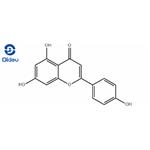
US $0.00-0.00/KG2025-11-21
- CAS:
- 520-36-5
- Min. Order:
- 1KG
- Purity:
- 98
- Supply Ability:
- 10000KGS
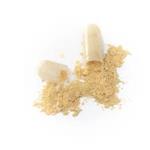
US $1200.00-1100.00/ton2025-09-29
- CAS:
- 520-36-5
- Min. Order:
- 1ton
- Purity:
- 99%
- Supply Ability:
- 1000T/M
